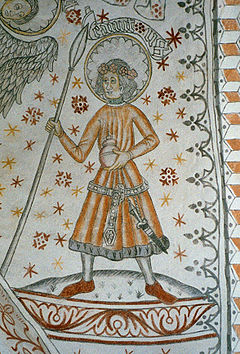| Saint Knut's Day | |
|---|---|
 Canute Lavard | |
| Also called | tjugondag jul, tjugondag Knut, knutmasso |
| Observed by | Sweden,[1] Finland,[1] Estonia |
| Date | 13 January |
| Frequency | annual |
Saint Knut's Day[2] (Swedish: tjugondag jul, lit. 'twentieth-day Christmas'; tjugondag Knut, lit. 'twentieth-day Knut'; or knutmasso;[3] Finnish: nuutinpäivä, lit. 'Knut's Day'), or the Feast of Saint Knut, is a traditional festival celebrated in Sweden and Finland on 13 January. It is not celebrated on this date in Denmark despite being named for the Danish prince Canute Lavard, and later also associated with his uncle, Canute the Saint, the patron saint of Denmark.[4][5][6] Christmas trees are taken down on tjugondag jul, and the candies and cookies that decorated the tree are eaten. In Sweden, the feast held during this event is called a Knut's party (julgransplundring, literally 'Christmas tree plundering').[7]
- ^ a b Editors of Chase's (15 November 2021). Chase's Calendar of Events 2022: The Ultimate Go-to Guide for Special Days, Weeks and Months. Rowman & Littlefield. p. 82. ISBN 978-1-64143-504-8.
- ^ "St. Knut's Day definition of St. Knut's Day in the Free Online Encyclopedia". Encyclopedia2.thefreedictionary.com. Retrieved 13 January 2014.
- ^ Karlsson, Kenneth. "Knut Photos". Knutmasso Museum. Retrieved 14 January 2016.
- ^ Cite error: The named reference
nordicwas invoked but never defined (see the help page). - ^ Henrikson, Alf (2013). Svensk Historia [Swedish History] (in Swedish). Albert Bonniers Förlag. ISBN 978-9100136567.
- ^ "Knut kör julen ut" [Knut drives out Christmas]. www.firajul.nu. FiraJul. Archived from the original on 8 December 2013. Retrieved 14 January 2016.
- ^ "Julgransplundring: Rocking around the Christmas Tree". Your Living City. 3 January 2014. Retrieved 10 January 2016.